Budget gaming notebook shootout: No need to break the piggy bank
Note: This article was first published on 26th July 2017.
Gaming doesn’t have to be an expensive hobby
How much gaming performance do you really need? A lot of that depends on the sort of gaming experience you expect. Do you want to run all the latest AAA titles at max settings and over 60fps? Or perhaps you’re okay with just dialing back the settings and settling for a playable, but not necessarily ultra-smooth, experience.
Gaming systems are frequently associated with stiff price tags, but not the notebooks we’re reviewing here today. Equipped with an Intel Core i7-7700HQ (2.8GHz, 6MB L3 cache) and NVIDIA GeForce GTX 1050 Ti, they all offer decent gaming performance at relatively affordable prices.
For instance, one of our review units, the Aftershock MX-15 Elite, starts at just S$1,674, which is an easy-to-stomach price for performance that will run most games at 1080p and Medium settings.
But lest you think that this is just a euphemism for generally terrible gaming performance, we should point out that the GeForce GTX 1050 Ti is equivalent to, or in fact slightly better than, the previous generation’s GeForce GTX 970M. The latter was considered one of the top mobile GPUs in its time, so you’re really getting more for less money.
And if you’ve got your feelers out for a so-called budget gaming notebook, there’s a good chance that you’re looking less for a dedicated gaming machine and more for a capable all-rounder that can also handle some games.
As it turns out, it’s not that easy being a jack of all trades, although a few do come tantalizingly close. To find out, we've pit the following notebooks in this shootout:
Acer Aspire VX 15
Aftershock MX-15 Elite
Gigabyte Sabre 15
HP Omen 15
Lenovo Legion Y520
MSI GP62 7REX Leopard Pro
Here then are the specifications of the notebooks at a glance before we look at each offering up close and personal:-
|
|
|
|
|
| |
|
|
|
|
|
| |
|
|
|
|
|
| |
|
|
|
|
|
| |
|
|
|
|
|
| |
|
|
|
|
|
| |
|
|
|
|
|
| |
|
|
|
|
|
| |
|
|
|
|
|
| |
|
|
|
|
|
| |
|
|
|
|
|
| |
|
|
|
|
|
| |
|
|
|
|
|
|
Acer Aspire VX 15
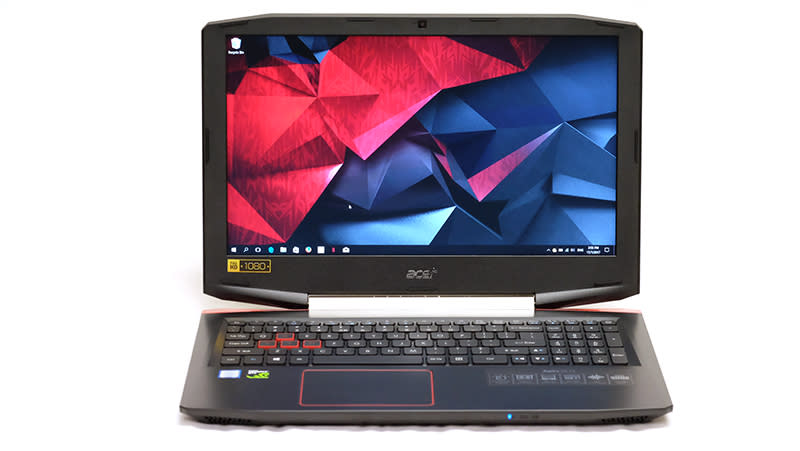
The Acer Aspire VX 15 isn’t a member of the company’s high-end Predator gaming range, but there’s a good chance that it’ll sell more units than the fancy (and also prohibitively expensive) Predator 15.
Acer has gone ahead and given the VX 15 a more gamer-oriented design anyway, with sweeping lines, red accents, and a brushed metal finish on the lid.
There are also two large stylized vents at the rear where the notebook spits out hot air, and they’re reminiscent of what you’d see on a four-wheeled speed demon.
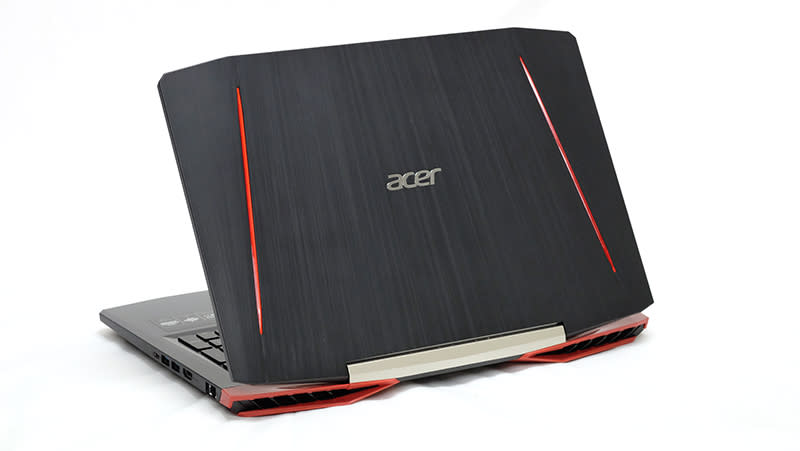
The entire machine appears quite bulky and muscly, to the point that it looks a bit more powerful than it really is. Still, we’d have preferred a more toned-down design ‒ there’s really no need for the glossy plastic that wraps around the exhaust vents, and the silvery display hinge doesn’t really go well with the rest of the notebook.
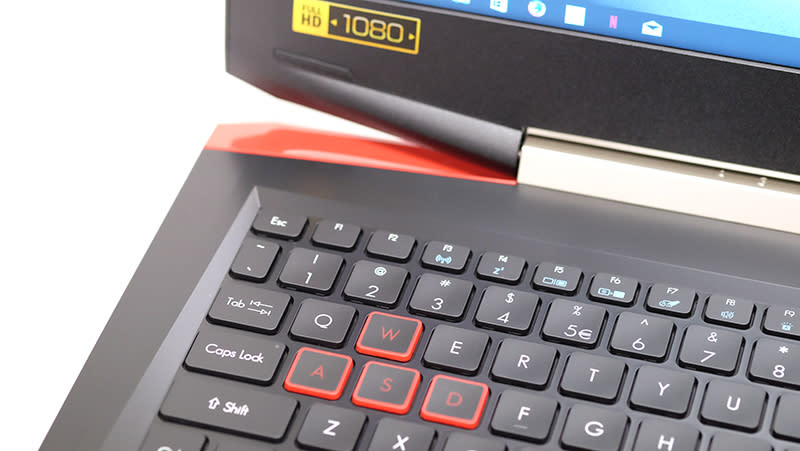
The VX 15 is cooled by two fans that do a fairly good job of keeping the laptop cool where it matters. The palm rests never got uncomfortably hot, but this is also a freakishly silent laptop even under load, so the CPU temperature actually peaked at a toasty 91°C, likely due to less aggressive fan speeds.
The Aspire VX 15 also uses just two heatpipes ‒ one each for the CPU and GPU ‒ so that might account for the higher temperatures as well.
The good news is that performance doesn’t seem to be affected in any way, and the VX 15 passed our 3DMark Fire Strike Extreme Stress Test and performed in line with the rest of the competition.
The NVIDIA GeForce GTX 1050 Ti is no gaming powerhouse, but it is a decent entry-level GPU that should run most games at 1080p and Medium settings. That said, you’re out of luck if you want to run VR games, as you’ll need at least a GeForce GTX 1060 for that.
The VX 15 comes with a good selection of connectors, including a USB 3.1 (Gen 1) Type-C port, two USB 3.0 ports, one USB 2.0 port, and a full-sized HDMI output.


The keyboard is pleasant to use with good key travel distance, and it sports a single-color red backlight that will help you pick out keys in the dark. The backlighting options are quite limited however, and there’s not even an option to adjust the brightness level. In comparison, laptops like the Aftershock MX-15 Elite and Gigabyte Sabre 15 support three-zone RGB customizations and even keyboard macros.
The left- and right-click buttons integrated into the trackpad could do with crisper feedback as well, and we couldn’t help thinking that they felt mushy at times.

When it came to the screen, the 1080p IPS panel was a bit disappointing. Colors appeared vapid, and the screen wasn’t quite bright enough even at maximum settings. Your movies and games definitely aren’t going to pop, so don’t expect the most visually immersive experience. Still, the screen has a matte coating, and that’s a small mercy under bright overhead lighting.
The front-facing speakers are loud, but the sound feels boomy, and the palm rests vibrate quite noticeably even at moderate volumes. These speakers are actually among the better sounding ones in this shootout, but the reverberations that can be felt through the palm rests might be a bit distracting when in game.
Our review unit came with a 256GB SSD and 16GB of RAM, and costs S$1,998, and its main advantage is its larger SSD, which will let you fit more games on board. Still, you already have a 1TB HDD for extra storage, so it might have been better to go for a cheaper 128GB drive like everyone else.
Acer also sells a cheaper model with a 128GB SSD, 8GB of RAM, and a GeForce GTX 1050 that costs S$1,798, but it has a weaker GPU and is still more expensive than some of the other laptops with a GeForce GTX 1050 Ti.
Aftershock MX-15 Elite

Aftershock’s MX-15 Elite is based on the Clevo N850 notebook, and the entire laptop oozes a pleasantly utilitarian and functional feel. There are no garish trimmings or ostentatious branding, and the notebook feels solidly built and looks ready to show up for work.
One of the best parts of the notebook is the keyboard, which is the same as that found on the more powerful S-15. The keys are tactile with a good amount of feedback, and we don’t see a problem gaming or typing on it for long hours.
It also features three-zone customizable RGB backlighting and the ability to bind custom macros to individual keys, so you’ll be able to launch programs or execute complex combos in-game more quickly. This is a nice addition given its S$1,674 price tag, as pricier notebooks like the Lenovo Legion Y520 and Acer Aspire VX 15 only offer single-color backlighting.
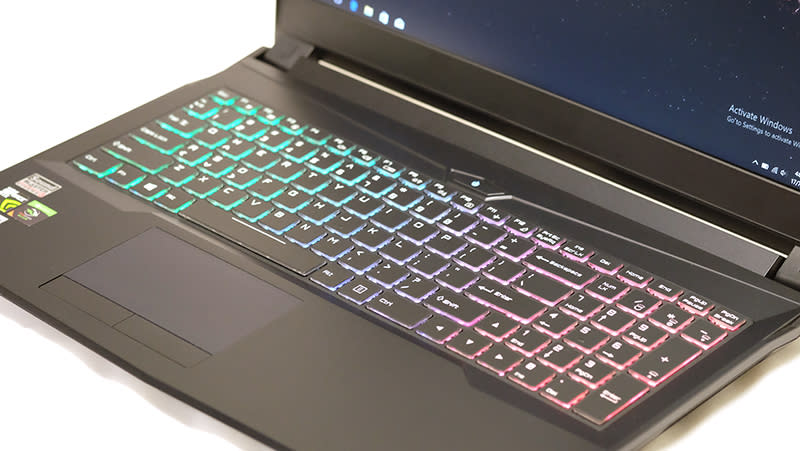
Another small but useful feature is the option disable the Windows key in the bundled Control Center utility, so you won’t accidentally find yourself staring at your desktop in the middle of a firefight.
The MX-15 Elite also has one of the most comprehensive selections of ports and connectors for a laptop of its class. There are a total of two Mini DisplayPort and one full-sized HDMI port, so it actually supports up to three external displays at once, a useful feature for anyone intending to use the notebook as a serious productivity machine.
In comparison, some of the other notebooks only come with one HDMI port, which is quite limited in terms of display options.
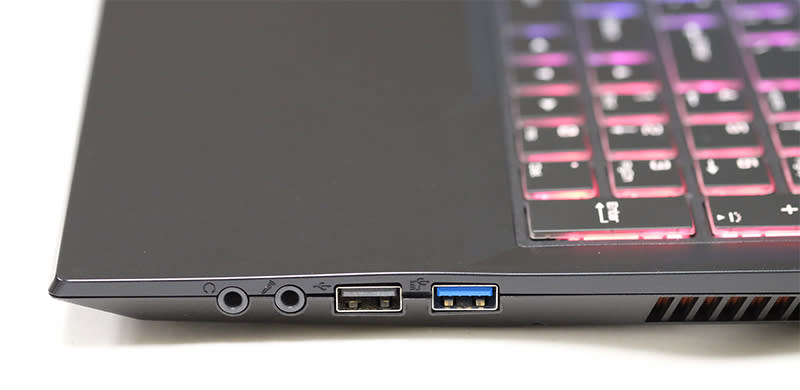

The 1080p IPS display could do with an extra oomph of brightness, but it was overall very useable with good viewing angles.
You can hear the cooling fan kick into higher gear while gaming, but it never became unbearably loud. Heat wasn’t a problem for us either, and at no point was the notebook excessively warm.
The MX-15 Elite uses four heatpipes to channel heat away from the key components, and the CPU and GPU get two heatpipes each.
The MX-15 Elite is equipped with a removable 47Wh battery pack, something you hardly see on notebooks these days. This is great news for those who intend to leave the laptop plugged in for long hours, even though most modern batteries have no problem with being juiced up all day.
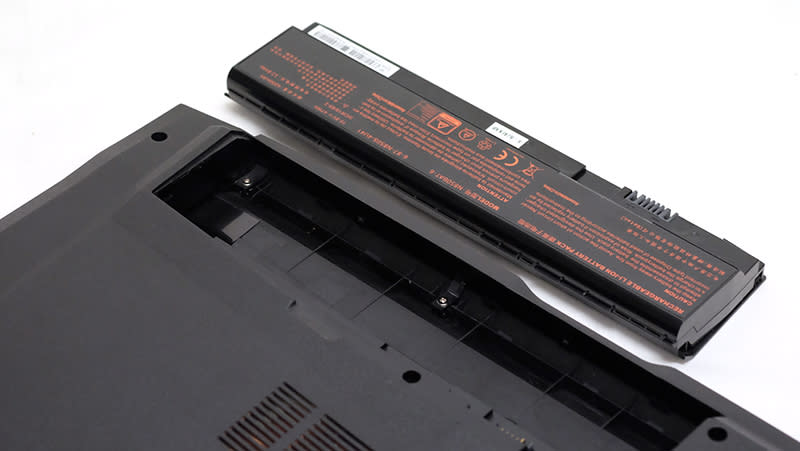
The notebook’s weak spot is probably its speakers. The dual speakers on the front pumped out teeny-sounding tunes that sounded like pale versions of their original recordings, so it’s probably best to grab a pair of good headphones if you want decent in-game audio.
Playing around with settings in the Creative Sound Blaster Cinema 3 software didn’t seem to help much. You can add a bit of bass or attempt to simulate a surround sound effect, but the speakers still continue to push out rather anemic-sounding audio.

The 128GB SSD is definitely a little small and probably won’t be able to hold more than a couple of good-sized games, but it is no worse than what the competition is offering. Most of the laptops ship with 128GB boot drives and a 1TB HDD, which gives users enough storage space while affording them the improved responsiveness of an SSD.
If you want a large SSD to hold all your games, you probably shouldn’t even be looking at a notebook in this price range.
Finally, Aftershock told us about certain tweaks it made to the laptop over the reference Clevo design. For instance, the original blew hot air directly out of the vents on the right edge, which meant that it could be quite uncomfortable if you were using a mouse close to the laptop. On the MX-15 Elite, the vents have been angled diagonally toward the back, so you won’t be bothered by the heat.
At S$1,674, this is the most affordable laptop in this shootout, and offers truly great bang for your buck.
Gigabyte Sabre 15

As it turns out, Gigabyte’s Sabre 15 is more or less the same laptop as the Aftershock MX-15 Elite. They’re both based on the same Clevo reference model, and save for some minor stylistic differences – a slightly different finish and keyboard lettering, among other things – they have the same keyboard layout and port arrangement.
This means that most of what we said about the MX-15 Elite applies here as well. It is plain and functional, although its spartan aesthetic may not appeal to everyone.
At S$1,799, it’s also slightly pricer than than MX-15 Elite, likely because of its larger 16GB of RAM. The extra memory won't make a large difference in games, but it may help with performance in memory-hungry tasks, such as when you’ve got a huge amount of Chrome tabs open, or when you’re editing photos.
The keyboard offers similar features and the same Control Center software as the MX-15 Elite, and you can customize the lighting color in three independent zones and bind macros to individual keys. The typing experience feels good as well, with decent travel distance and nice feedback.
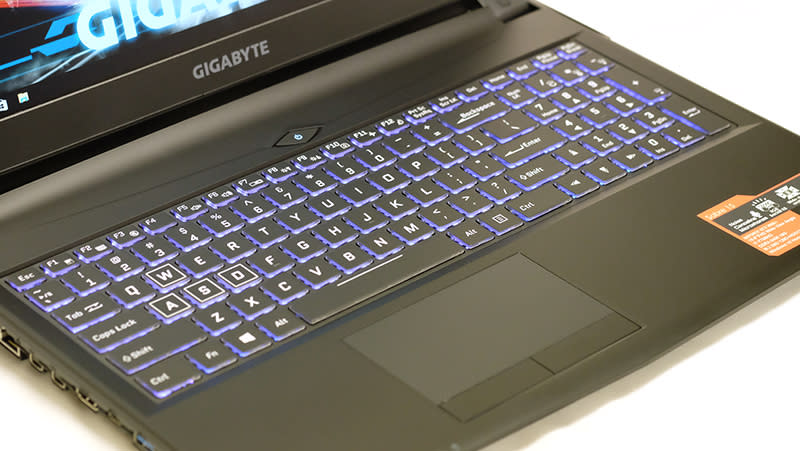
That said, one design quirk that’s present on both the Aftershock and Gigabyte laptops is the placement of the keyboard backlight button. The button to increase the brightness level is located below the one to decrease the brightness, and the counter-intuitive positioning takes some getting used to.
The Sabre 15 also shares very similar internals to the Aftershock MX-15 Elite. The same four heatpipes are used to keep the CPU and GPU chilly, and the Sabre 15 generally runs quite cool and quiet as well.
As on the Aftershock laptop, the Gigabyte’s display isn’t the brightest either, and you’ll have to pump it up close to 100 per cent brightness for the best experience. The screen also appeared to have a noticeably cooler bias, although it’s nothing overly bothersome.

When it came to audio quality, the dual speakers at the front failed to impress, and the Creative Sound Blaster Cinema 3 enhancements didn’t seem to do much more. Of course, this is pretty much par for the course for laptop speakers, such that it’s more of a surprise when a speaker turns out to be good rather than bad.
On the left, you’ll find two Mini DisplayPort and one full-sized HDMI output that supports up to three external displays at the same time, a useful inclusion for anyone planning to work with such extensive screen real estate.
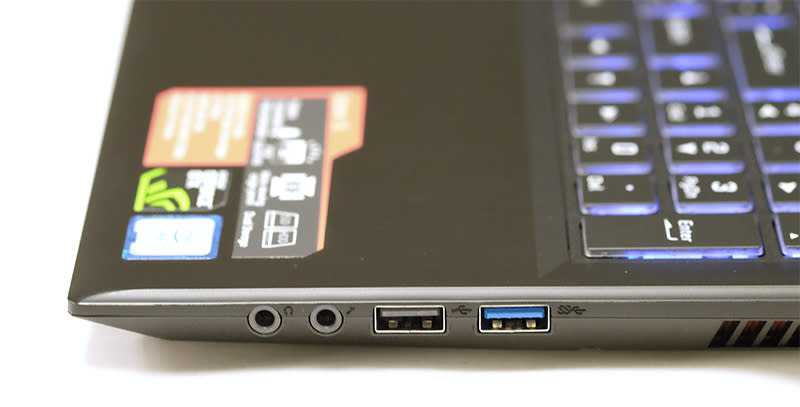

To cap things off, the 47Wh battery is removable as well, so you can leave it hooked up for hours on end.

Both the MX-15 Elite and Sabre 15 are fairly chunky and heavy notebooks at 2.5kg. They’re not the most portable devices around, but that’s a tradeoff you’ll have to make at this price range.
HP Omen 15

HP has given its Omen laptops a design makeover. While the hardware remains mostly unchanged, the new Omen 15 is a refreshing take on the Omen gaming brand, with far more character and visual flair.
The lid sports a distinctive X pattern and the Omen logo – it’s a little ostentatious, but it makes for quite a nice look overall. In addition, this is the thinnest notebook in this shootout at 24.8mm thick, although it is still quite hefty at a good 2.568kg.
The old Omen designs were almost boring, with safe contours and rounded edges. The updated Omen changes that with bolder, more aggressive lines and a hinge design that reminds us of what Lenovo did with the Legion Y520.
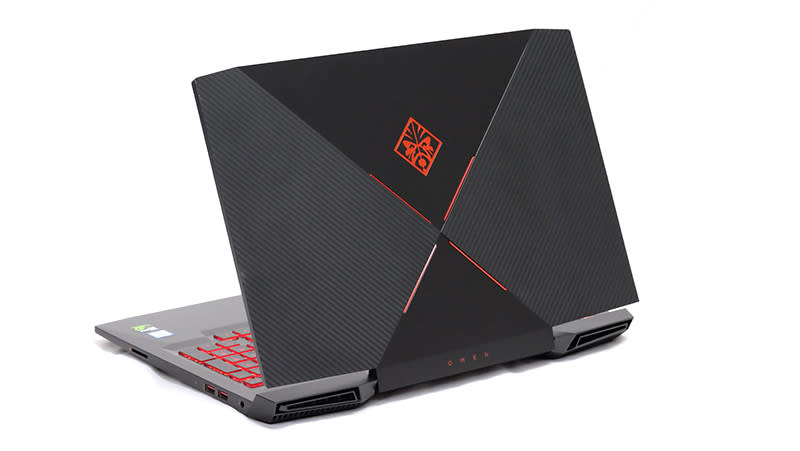
The hinge doesn’t cover the entire length of the notebook, so there’s quite a striking gap between the display and the body of the laptop. Two decorative grills flank the hinge, and they’re purely ornamental and not actually speakers as on the Lenovo Legion Y520. The real speakers are located at the bottom of the notebook, and the dual Bang & Olufsen-tuned speakers manage to pump out fairly decent sound.
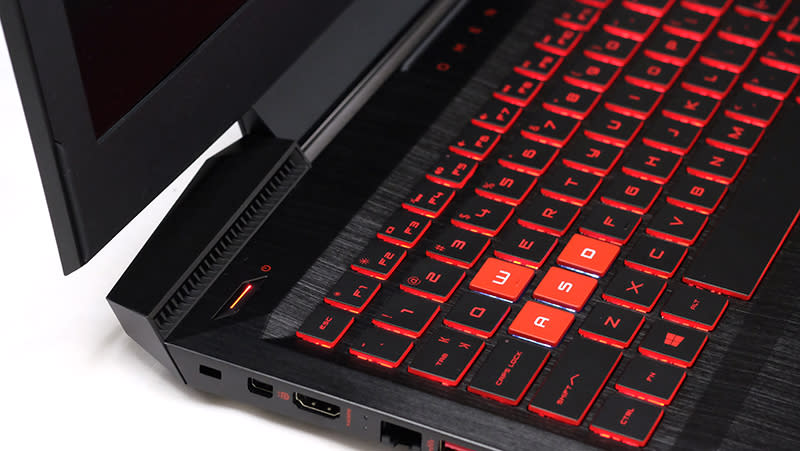
We’d even venture to say that these are the best speakers among all the notebooks we tested. Music sounded full-bodied, for a laptop that is, and the speakers can easily fill a room at less than maximum volume.
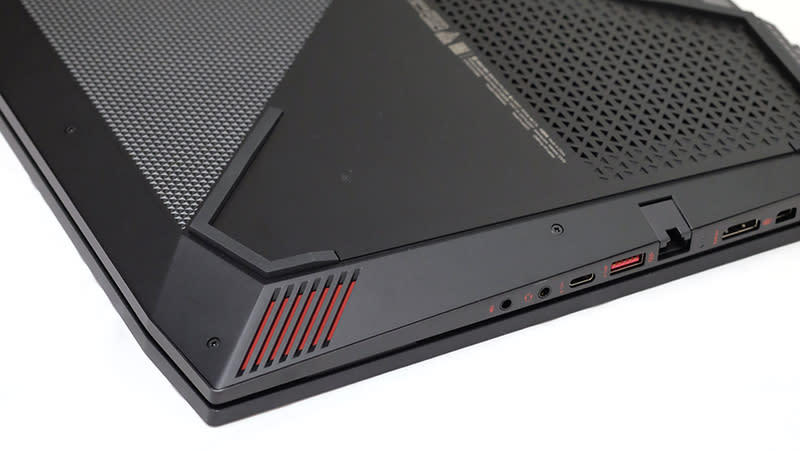
The base of the laptop also features a brushed metal finish for a slightly more upmarket look, and the laptop feels quite sturdily built as well. There’s almost no flex to the base, and the keyboard itself offers good key travel distance and quite a pleasant typing experience. Similarly, the trackpad felt responsive and accurate, which is not exactly a given even today.
The keyboard offers just a single-color red backlight, but the backlight toggle key lets you switch between lighting up the entire keyboard or just the WASD key cluster. In the latter case, the backlight is actually white.
Another nice touch is a built-in shortcut to disable the Windows key while in game, and you can activate it by hitting Fn + F12. On top of that, there is a dedicated Omen button that launches the Omen Command Center, which lets you view things like CPU and memory usage.
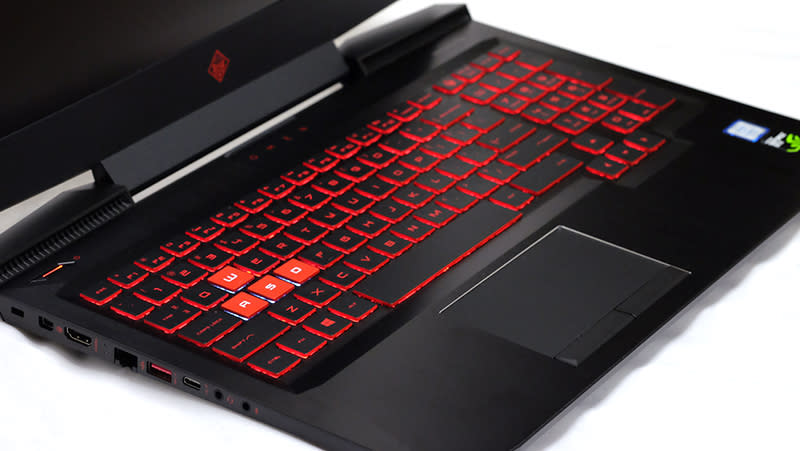
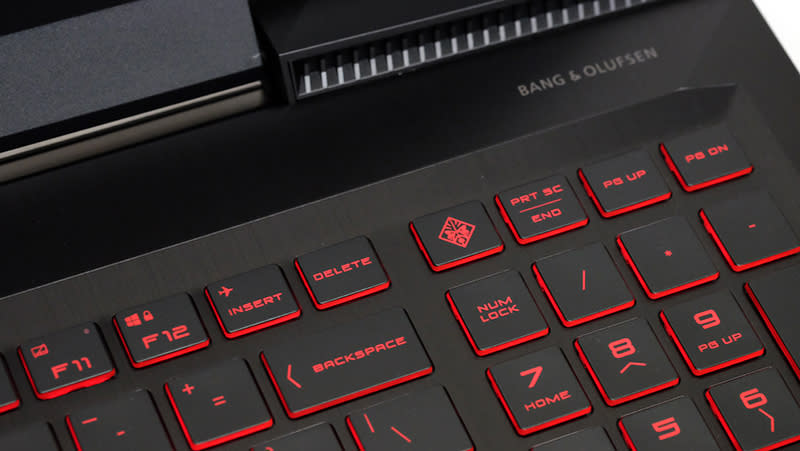
The 1,920 x 1,080-pixel IPS display has a matte coating that helps with overhead reflections, and the display is one of the better ones in this shootout. Pictures and games don’t appear washed out at the very least, and that’s probably what really matters.
When it comes to cooling, the Omen 15 is a rather quiet laptop, and it never gets excessively loud. HP also has something called CoolSense, which supposedly adjusts fans and system performance when you’re on the go.
You’ll find a decent selection of ports and connectors on board as well, including one HDMI and one Mini DisplayPort output, three USB 3.0 ports, and one USB-C connector. This is the only notebook to not have any USB 2.0 ports, so you’ll get faster transfers regardless of which connector you pick.
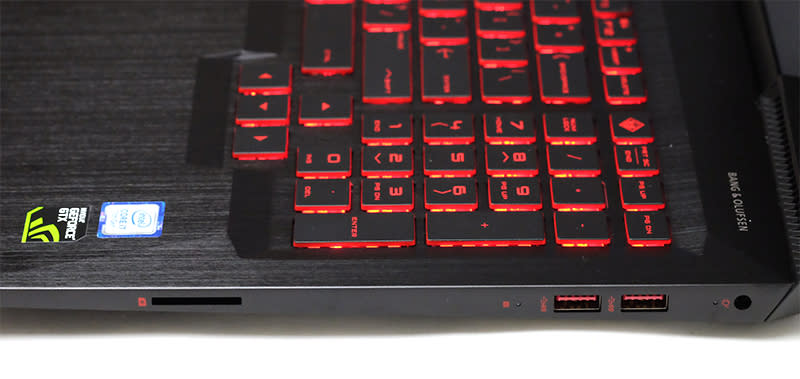

Finally, HP has also thrown in a 128GB Samsung PM961 PCIe NVMe SSD and 2x2 Realtek RTL8822BE wireless module, a nice step up from the SATA and 1x1 wireless modules on most of the other laptops. To cap matters off, HP has also crammed in a good-sized 70Wh battery, which means the Omen actually has the longest battery life out of all our tested notebooks.
The Omen 15 costs S$1,999, which alongside the MSI GP62 7REX Leopard Pro, makes it the most expensive laptop in this shootout. This is not a bad laptop, but it’s a little difficult to justify the price when you’re getting just 8GB of RAM for this class of GeForce GTX 1050 Ti based gaming notebooks.
Lenovo Legion Y520
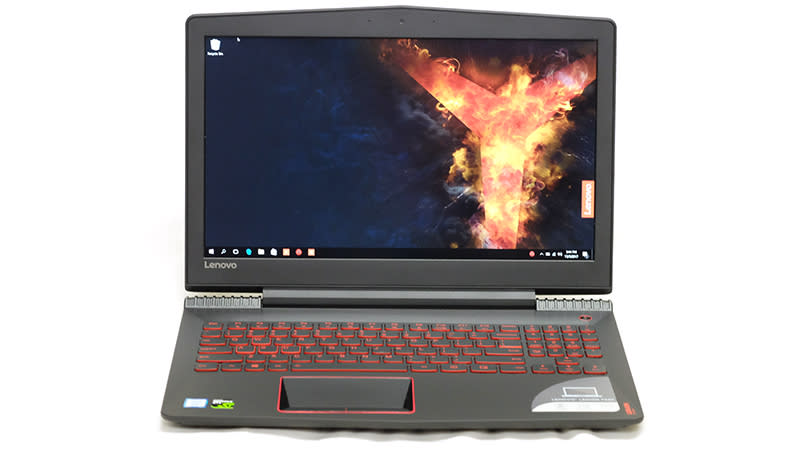
The Legion Y520 was one of the first notebooks to debut under Lenovo’s Legion gaming brand, and it has all the expected trappings of a laptop designed explicitly for gamers.
This includes things like a carbon fiber-esque finish on the lid, red lettering on the keyboard and trim around the trackpad, and a sleek brushed metal segment above the keyboard. Overall, the design feels tasteful while still managing to retain a distinctly gamer-centric appeal, and it’s probably one of the better looking notebooks in this shootout.
It also doesn’t hurt that it is one of the thinner notebooks of the lot, measuring in at 25.8mm thick, second only to HP. In addition, it feels solid and well-built, which is a very welcome impression at this price point.
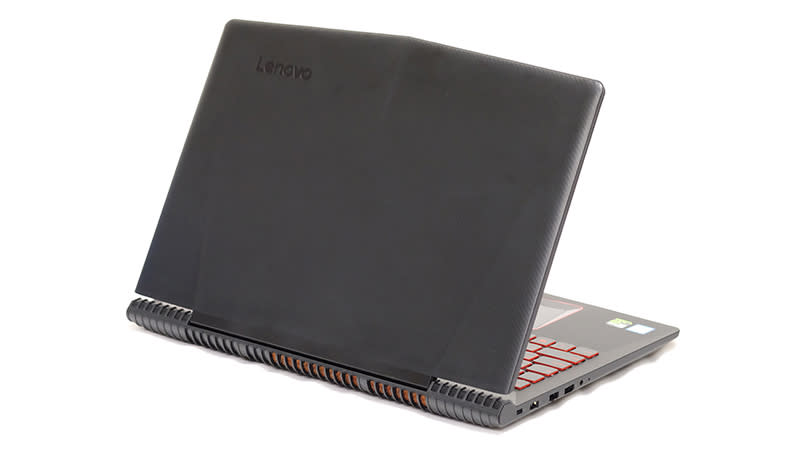
The dual Harman speakers sit on either side of the display’s hinge, and they project sound forward and above, a marked improvement from the speakers crammed on the edge of notebooks like the Aftershock MX-15 Elite and Gigabyte Sabre 15.
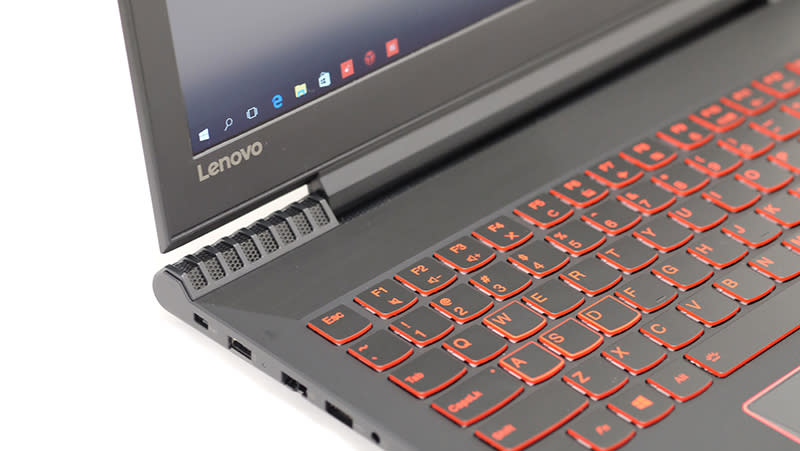
The Legion Y520 runs fairly cool, and we measured among the lowest CPU and GPU temperatures compared to the other notebooks.
One nice feature is something Lenovo calls Extreme Cooling, which instantly ramps up the fan speeds for particularly intensive workloads. You can activate this through Lenovo’s Nerve Sense software, or with a customizable keyboard shortcut.
The resulting fan noise is quite noticeable, but you do get quite a large boost in cooling, to the tune of a nearly 10°C drop in peak GPU temperatures. The Legion Y520 is cooled by dual fans and two heatpipes shared between the CPU and GPU, and this design keeps the laptop running quite cool, with among the lowest GPU temperatures tested.
Another welcome inclusion is the 128GB Samsung PCIe NVMe SSD, as most of the other notebooks feature slower SATA-based drives. The Legion Y520 also comes with a 2x2 Intel Dual Band Wireless-AC 8265, compared to the 1x1 configuration its competitors use.
The keyboard itself feels nice enough to type on, and there's little to complain. But as on the Acer Aspire VX 15 and HP Omen 15, there’s no way to change the color or brightness of the backlight, so you’re just stuck with red.
However, the left- and right-click buttons below the trackpad can feel a little difficult to click at times, and we’d much rather not have a glossy finish. Just a short period of use renders them less than pristine, and you’ll have to wipe them down frequently if you’re particular about fingerprints or just the general appearance of your notebook.

The Legion Y520 is also a little lacking when it comes to display outputs. There is just a single HDMI output, the same as on the Acer Aspire VX 15, so you’re a bit limited if you’re gunning for a multi-display setup. Furthermore, it sports a single headphone and microphone combo jack, which means you'll need an adapter if you've got a headset that requires dedicated ports for audio and the microphone.

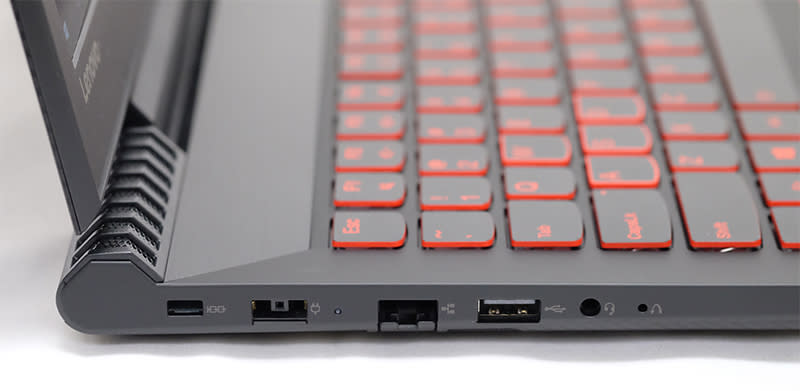
Finally, the display could also use some improvement, as colors could appear a little dull, and anything short of maximum brightness felt unpleasantly dim. It’s looking like the screen is one of the areas where many manufacturers have chosen to compromise on in this price range, so it’s just a matter of picking your poison.
MSI GP62 7REX Leopard Pro
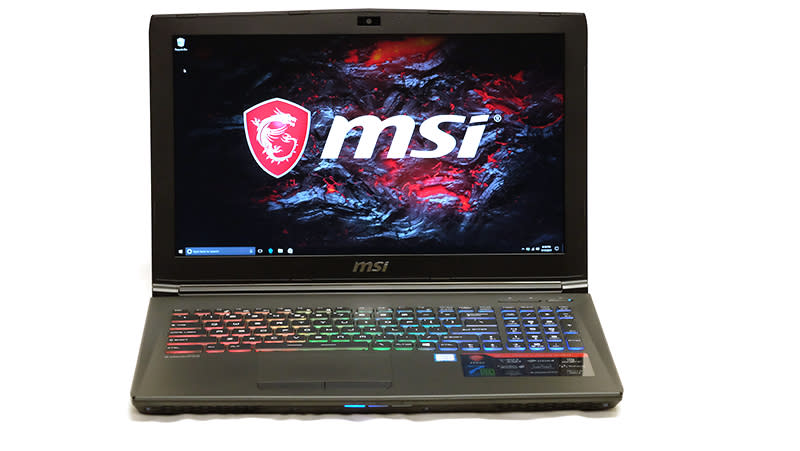
MSI’s GP series hosts its budget range of gaming notebooks, and the GP62 7REX Leopard Pro aims to blend affordable specifications with a compelling mix of value-added features.
It isn’t going to win any design accolades, and is a rather thick and heavy notebook, measuring 29mm at its thickest point and weighing 2.4kg. MSI has incorporated a brushed metal finish on the lid for a slightly more premium feel, but there’s no getting away from the predominantly plastic build.
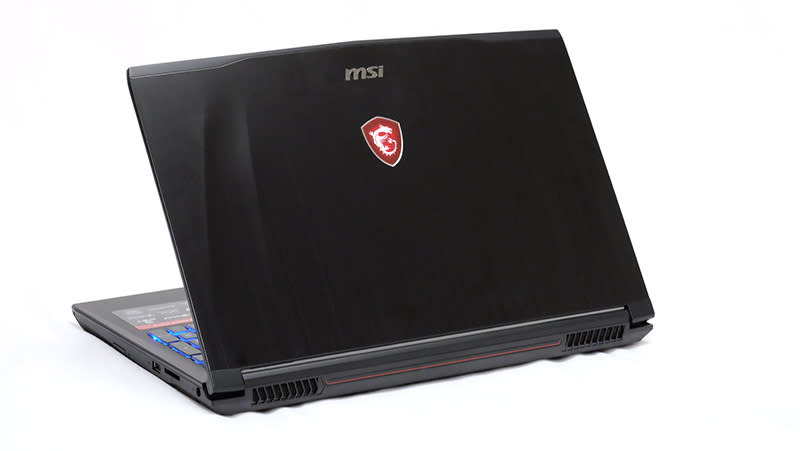
Still, this is pretty much to be expected in this price bracket, and the GP62 distinguishes itself with a handful of useful features.
Like the Lenovo Legion Y520, the MSI notebook lets you manually boost the cooling during intensive workloads. The fans do become quite audible, but there’s nearly a 10°C drop in peak CPU temperatures. The feature can be activated with the dedicated Cooler Boost 4 button at the top right, so it’s really convenient to use.
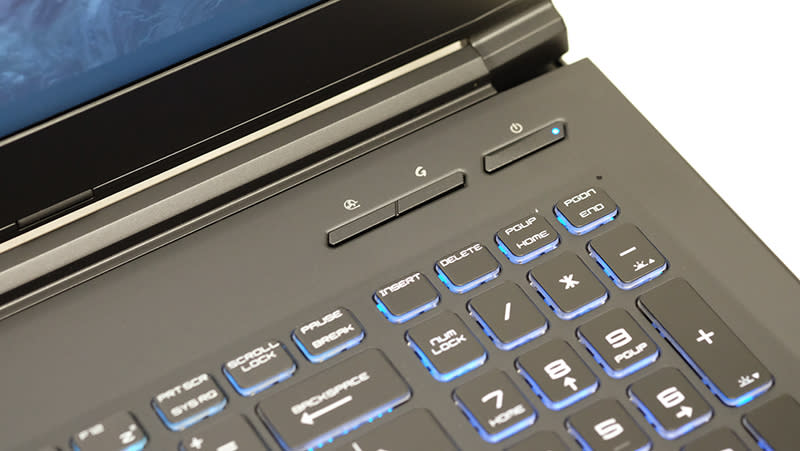
The GP62 7REX Leopard Pro also has one of the most elaborate cooling designs in this shootout, comprising a total of six heatpipes – three each for the CPU and GPU – and two fans.
A second button beside the Cooler Boost key lets you toggle between different lighting effects, so there’s no need to enter the MSI Dragon Centre utility to manually switch things up. That said, if you want extra customizations, the keyboard still supports customizable three-zone RGB backlighting and three levels of brightness.
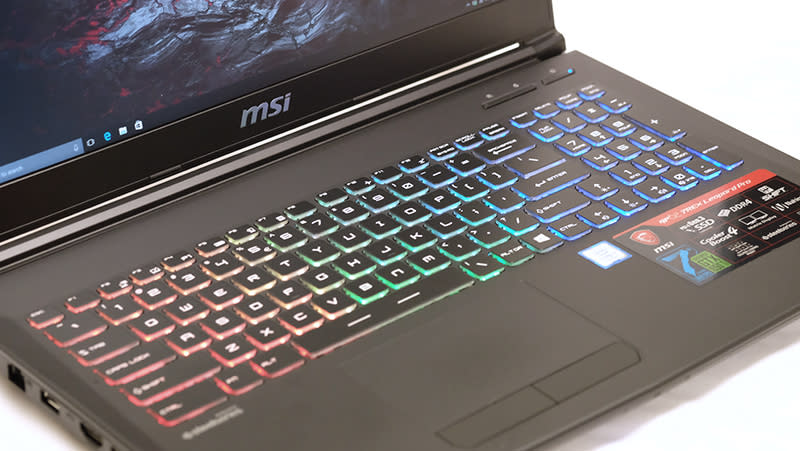
Another useful feature is the support for GPU overclocking in the Dragon Centre software. MSI offers something called Shift mode, and setting the laptop to Turbo mode lets you overclock the GPU and the memory. Alternatively, you can shift down to Eco mode for cooler and quieter operation.
There’s not much to be had out of overclocking a GeForce GTX 1050 Ti, but the different settings do allow for an additional degree of flexibility. After overclocking the GPU and memory by 200MHz and 160MHz respectively, we were able to squeeze out an 8 per cent improvement in 3DMark Fire Strike, so you do have the freedom to tinker around for a bit more performance.
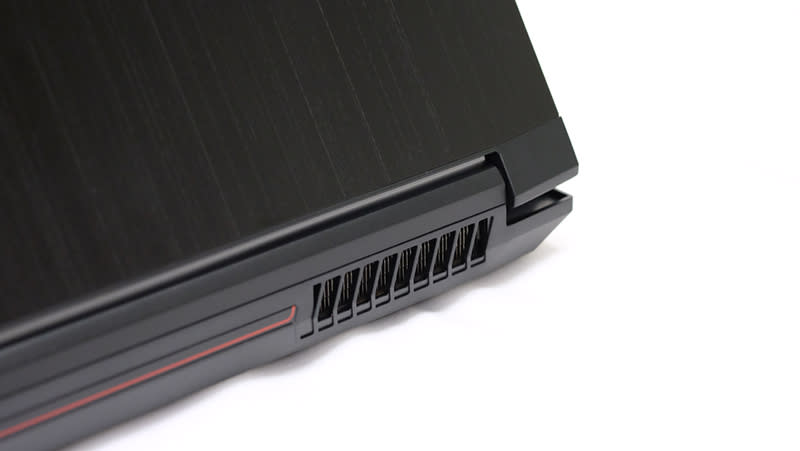
MSI is also keen to emphasize its Nahimic audio technology, which supposedly helps improve audio and voice clarity and can come in very handy in game. It’s an audio tweaking tool much like Creative’s Sound Blaster Cinema 3, and you can also customize certain aspects of the sound output like the bass and treble output.
The GP62’s forward-facing speakers are fairly decent and avoid sounding thin and shrill, but they’re also nothing much to get excited about.
The display is a 94% NTSC wide-view IPS-type panel, but it suffers from especially poor vertical viewing angles and the screen has a noticeably cooler hue to it.
Another quirk is the inclusion of a DVD Super Multi drive on the right of the laptop. This isn’t necessarily a bad thing, but we can’t even remember the last time we used a CD or DVD, and it just feels like a superfluous feature that adds to the cost of the notebook and makes it thicker than it could have been.
On the left, you'll find the a variety of connectivity options, such as dedicated HDMI and MiniDisplayPort outputs.


At S$1,999, the laptop is quite pricey for the level of performance it offers, especially when you consider the fact that the Acer Aspire VX 15 costs about the same but includes a 256GB SSD and 16GB of RAM.
Still, MSI attempts to justify the price somewhat with its additional cooling and easy-to-use overclocking features.
Test Setup and Performance
Here’s a full list of the notebooks we’re looking at:
Acer Aspire VX 15
Aftershock MX-15 Elite
Gigabyte Sabre 15
HP Omen 15
Lenovo Legion Y520
MSI GP62 7REX Leopard Pro
All the notebooks are equipped with an Intel Core i7-7700HQ (2.8GHz, 6MB L3 cace) processor and an NVIDIA GeForce GTX 1050 Ti GPU. They differ mainly in terms of storage and memory capacity, so performance is quite similar across the board.
|
|
|
|
|
| |
|
|
|
|
|
| |
|
|
|
|
|
| |
|
|
|
|
|
| |
|
|
|
|
|
| |
|
|
|
|
|
| |
|
|
|
|
|
| |
|
|
|
|
|
| |
|
|
|
|
|
| |
|
|
|
|
|
| |
|
|
|
|
|
| |
|
|
|
|
|
| |
|
|
|
|
|
|
Finally, we also ran the laptops through the following benchmarks. PCMark 8 has been replaced with the newer PCMark 10, which features a better representation of modern workloads.
PCMark 10
3DMark (2013)
VRMark
Ashes of the Singularity
Deus Ex: Mankind Divided
Tom Clancy’s The Division
We used the 3DMark Fire Strike Extreme Stress Test for temperature measurements, and the battery life benchmark in PCMark 8 Home to test the battery (PCMark 10 doesn’t yet come with a built-in battery benchmark).
PCMark 10 Extended
PCMark 10 Extended assesses the performance of systems in a variety of workloads, including basic computing tasks, productivity applications, digital content creation, and gaming. Compared to PCMark 8, it also adds in new test metrics, such as app startup times, which quantifies how long it takes to launch a variety of real-world apps, and a rendering and visualization workload to simulate professional graphics and engineering applications. In addition, existing workloads have been updated to reflect modern usage.
However, this is a balanced benchmark that takes into account performance in varied scenarios, and as such does not highlight the strengths of these gaming systems. But since there’s a good chance that you’ll be using one of these notebooks for more than just gaming, the figures here are of interest as well.
All the tested notebooks performed very similarly, which is unsurprising given their nearly identical specifications. Furthermore, a look at the breakdown of the scores for the different test groups reveals few significant differences as well.
To put things in perspective, a minuscule 4 per cent difference separates the Acer Aspire VX 15 and Aftershock MX-15 Elite, the so-called top and bottom performers respectively. Ultimately, it will be things like design, battery life, and price that decide a winner.


3DMark (2013)
3DMark is a more relevant assessment of gaming performance, and it puts the system through a range of graphics and computational performance tests at different resolutions, starting at 1080p and going all the way up to 4K.
Unsurprisingly, all the laptops were neck-and-neck with each other, but the Gigabyte Sabre 15 did manage to run away with a sliver of a lead.

VRMark
Futuremark’s VRMark benchmark is designed to assess a PC’s ability to handle high-performance headsets like the HTC Vive and Oculus Rift. If a PC passes the Orange Room test, it is ready for the latter two systems.
The limitations of these budget GeForce GTX 1050 Ti become clear here as none of the notebooks managed to pass the Orange Room test. There’s a target frame rate of 109FPS, but all the laptops fell short of that. These are not VR-ready laptops, and if you’re hoping to get something that can power your Vive or Rift, you’ll need to step up to a GeForce GTX 1060.


Ashes of the Singularity
Ashes of the Singularity is a demanding real-time strategy game that puts thousands of units on screen, and it’s capable of pushing even the most powerful GPUs.
The GeForce GTX 1050 Ti laptops are able to deliver a relatively playable experience at 1080p and High settings, but ramping the graphics up to Ultra is pushing things. But for the best experience, you’d probably want to take things down to Medium settings or even lower.
That said, the Acer and Gigabyte laptops squeaked ahead here, although not by any game-changing amount.

Deus Ex: Mankind Divided
Mankind Divided is one of the most demanding titles to run today, but the good news is that a GeForce GTX 1050 Ti laptop will actually deliver a fairly playable experience, provided you turn the settings down.
Performance was once again very similar across the board, although the Gigabyte Sabre 15 did stand out as the top performer. That said, there was a performance drop when switching from DirectX 11 to 12, so it’s probably best to stick with the former.
A low-level API like DirectX 12 helps alleviate CPU bottlenecks by allowing it to process more draw calls per second, but there’s no use in stuffing more draw calls into the GPU pipeline of a card like the GeForce GTX 1050 Ti if it already has its hands full keeping up with the game at hand.

Tom Clancy’s The Division
The Division isn’t as demanding to run as Ashes of the Singularity or Deus Ex: Mankind Divided, but its Snowdrop engine can still stress cards with the use of dynamic lighting and the like.
The Gigabyte Sabre 15 edged ahead again here, but the rest of the notebooks were very close behind. Either way, it looks like you should be able to run the game fairly smoothly if you opt for Medium settings or lower.

Temperature
We measured the external temperatures of the four quadrants of the notebook after looping the 3DMark Fire Strike Extreme stress test for 15 minutes. This amount of time is more than enough to get an idea of your average maximum running temperature for this workload.

Battery life and power consumption
The HP Omen 15 led the pack with the longest battery life, no doubt thanks to its large 70Wh battery. The Aftershock MX-15 Elite and Gigabyte Sabre 15 followed close behind, even though their batteries were approximately 30 per cent smaller. These notebooks aren’t quite desktop replacements yet, so battery life is still a fairly important consideration.
The MSI GP62 7REX Leopard Pro did especially poorly, managing just under two hours. According to MSI, this is because the CPU and GPU have been tuned to maintain their aggressive clock speeds even in battery mode, which translates into higher power consumption and shorter battery life.
While we appreciate MSI’s efforts to keep up performance while away from an outlet, it seems to be a case of misplaced priorities. If you’re unplugged, you’re more likely to be working than gaming, and so would benefit more from having a longer-lasting battery.


Portability index
Our portability index is an objective measure of how portable a notebook is, taking into account factors like size, weight, and battery life.
The HP Omen 15 turned out to be the most portable, thanks to its strong battery life numbers and slim dimensions compared to the rest of the notebooks. The MSI GP62 7REX Leopard Pro brought up the rear end, bogged down by its poor battery life and chunky build.

And the winner is...

The notion of a budget gaming notebook seems supremely bland, tepid, and uninteresting. Gaming is an expensive hobby, and it’s often the premium products that generate the most interest with their cutting-edge designs and blazing fast performance.
However, progress on the GPU front means that you don’t have to look at a so-called entry-level gaming notebook like it’s something the cat dragged in. As we mentioned earlier, the GeForce GTX 1050 Ti offers performance similar to last generation’s GeForce GTX 970M, a mobile GPU that found its way into many high-end laptops.
If you’re looking for an affordable gaming laptop, today’s budget notebooks are capable of running most games at 1080p and Medium settings.

HP’s Omen 15 is a solid and well-rounded laptop that more than makes up for its S$1,999 asking price with an attractive design and thoughtful features. In a field that offers relatively similar performance, the Omen 15 stands out because of its long battery life and relatively good audio quality and display. It also comes with a 2x2 Wi-Fi module and PCIe NVMe SSD, which stacks up well against the 1x1 module and SATA drives found on some of the other laptops. On top of that, it supports dual displays with the HDMI and Mini DisplayPort outputs, whereas the Acer and Lenovo notebooks only have a single HDMI port. Finally, we also like that HP ditched slower USB 2.0 connectors in favor of USB 3.0 across the board, the only laptop in this shootout to do so. It's difficult to attract notice in such a homogenous arena, but HP has made quite a winner with the Omen 15.
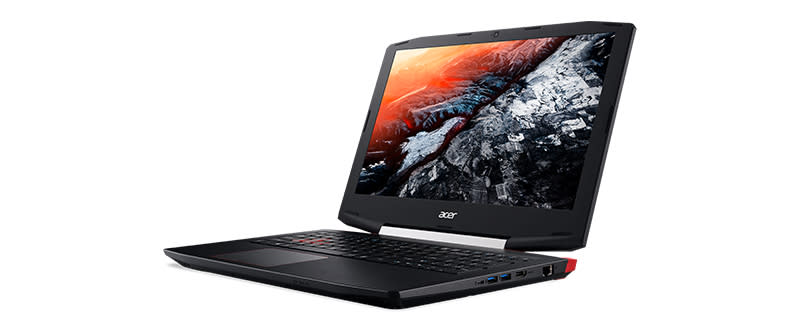
Acer’s Aspire VX 15 laptop offers fairly competitive specifications – a 256GB SSD and 16GB of RAM – for its S$1,998 price tag, but that still actually feels a bit pricey for this level of performance. Furthermore, it is bogged down by its bulky frame and lacks features like the customizable RGB lighting found on the cheaper Aftershock MX-15 Elite and Gigabyte Sabre 15. While it is hardly a bad laptop, the screen truly leaves a lot to be desired, and this is a tough pill to swallow when the Aftershock and Gigabyte laptops both offer better-looking displays.

The Aftershock MX-15 Elite shares a lot in common with Gigabyte’s Sabre 15, and the both of them are actually based on the same Clevo reference design. The MX-15 Elite is also the cheapest and laptop in this shootout at just S$1,674. Aftershock offers the key essentials to get a decent gaming experience while saving you some dollars in the process, but the Gigabyte laptop ultimately gained an edge because of its better performance and higher memory capacity for around a hundred dollars more. Still, there’s a lot to like about this notebook, and it is also capable of supporting up to three displays without the need for any extra accessories, just like the Sabre 15.
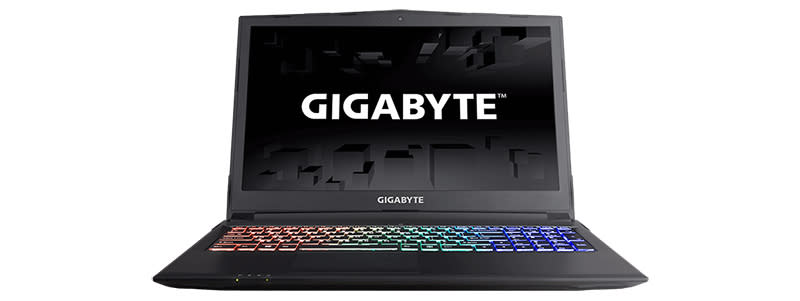
The Gigabyte Sabre 15 offers a judicious blend of competitive specifications and affordability. At S$1,799, it is the second cheapest notebook in this shootout, but it offers 16GB of RAM, the only other notebook here to do so other than the S$1,998 Acer Aspire VX 15. The additional memory will come in handy for heavy multi-tasking, but the Sabre 15 also inches to the top of the pack in terms of gaming performance. To cap things off, the Sabre 15 also offers customizable three-zone RGB backlighting and a decent screen, which is more than can be said for many of the other notebooks. All things considered, Gigabyte's Sabre 15 is easily our best value recommendation as it has more consistent performance than Aftershock's offering and its step up price is easily justified with the added memory and SSD capacity. If simplicity and functionality are what you need, this notebook has you covered well.

The Lenovo Legion Y520 is one of the better looking laptops here. As a member of Lenovo’s new Legion gaming brand, it has an unmistakably gaming-oriented focus while still retaining a modicum of taste. This is a solid and well-built laptop with a nifty feature for boosting cooling on-the-fly, but it ultimately sits in the middle of the pack with its S$1,899 price. It brings to the table a 128GB PCIe SSD and a 2x2 Wi-Fi module, but it is also bogged down by an unorthodox keyboard design – no dedicated keys for things like Page Up, Page Down, or Print Screen – and a dim, unimpressive display. Furthermore, unlike most of the competition, it only has a single headphone and microphone combo jack, so you may need an adapter with certain gaming headsets.
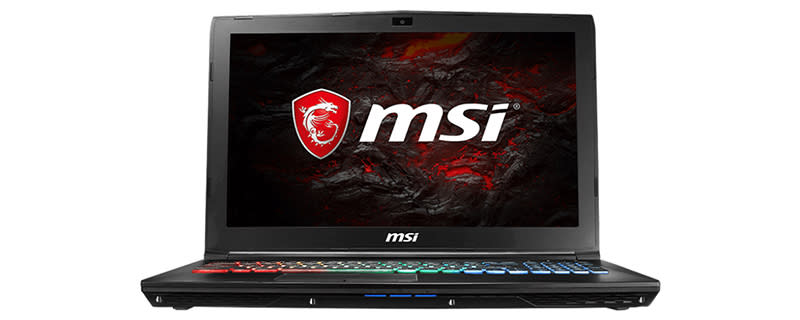
Finally, the MSI GP62 7REX Leopard Pro bears the ungainly distinction of being the most expensive laptop in this shootout. At S$1,999, it’s easy to make the case for shelling out a few hundred dollars more for a laptop with a GeForce GTX 1060. MSI attempts to justify the price with a bevy of features, such as its Cooler Boost technology for extra cooling, customizable RGB backlighting, easy GPU overclocking, and a DVD drive, but these don’t feel as useful as the ability to support up to three external displays as on the Aftershock and Gigabyte laptops. This is no doubt one of the more feature-rich laptops in this line-up, but a more streamlined approach and a thinner design (by removing the DVD drive) would have felt more prudent. Of course, its abysmal battery life also doesn't help its case.
Model/Criteria | Acer Aspire VX 15 | Aftershock MX-15 Elite | Gigabyte Sabre 15 | HP Omen 15 | Lenovo Legion Y520 | MSI GP62 7REX Leopard Pro |
|---|---|---|---|---|---|---|
6.5 | 7.5 | 7.5 | 8.5 | 8.0 | 7.5 | |
7.0 | 7.5 | 7.5 | 8.0 | 7.5 | 8.0 | |
7.5 | 7.5 | 7.5 | 8.0 | 7.5 | 7.5 | |
7.5 | 8.5 | 8.5 | 7.5 | 7.5 | 7.0 | |
7.0 | 7.5 | 8.0 | 8.5 | 6.5 | 5.0 | |
7.0 | 8.0 | 8.0 | 8.0 | 7.5 | 7.0 | |
$1,998 | $1,674 | $1,799 | $1,999 | $1,899 | $1,999 |
 |  |
 |  |
 |  |
 |  |
 |  |
 |  |











